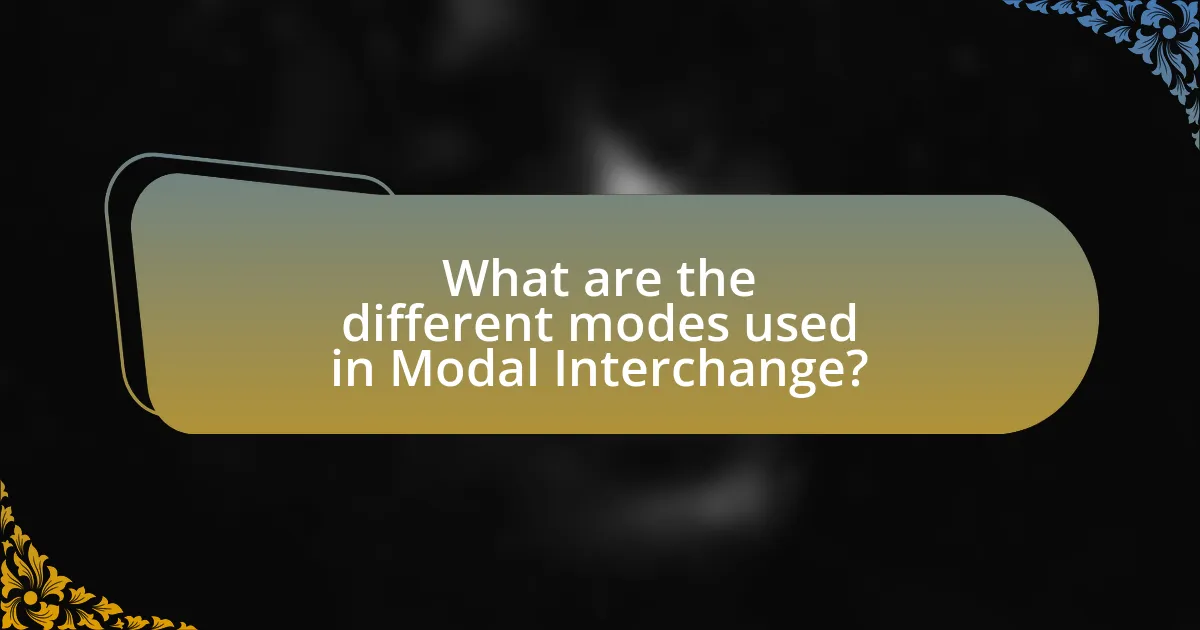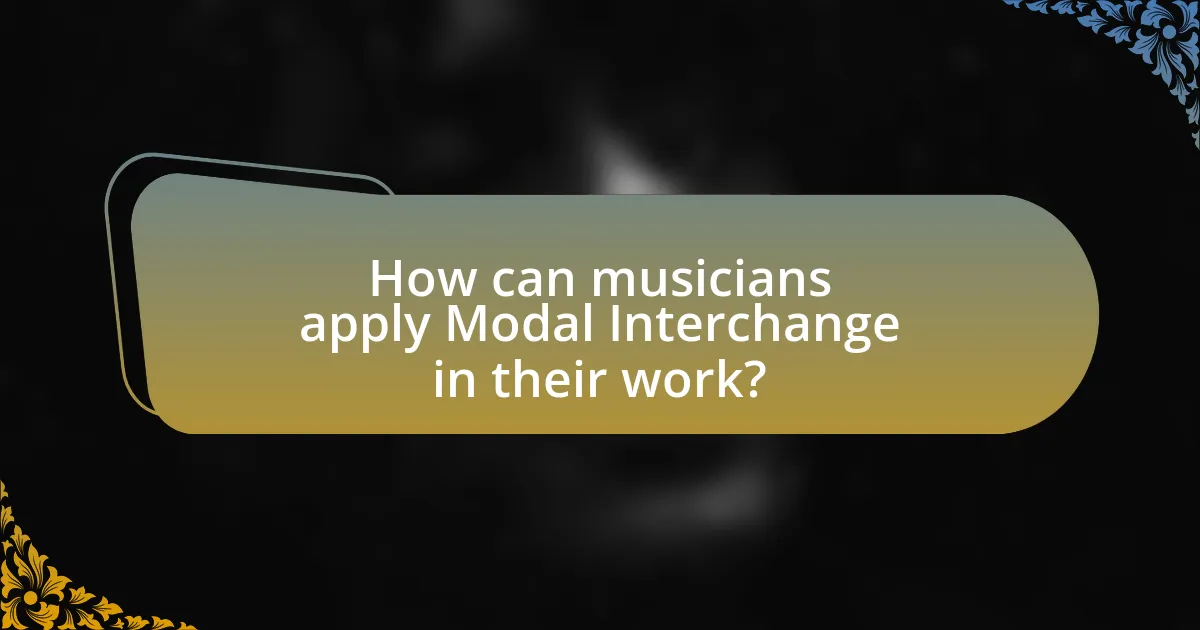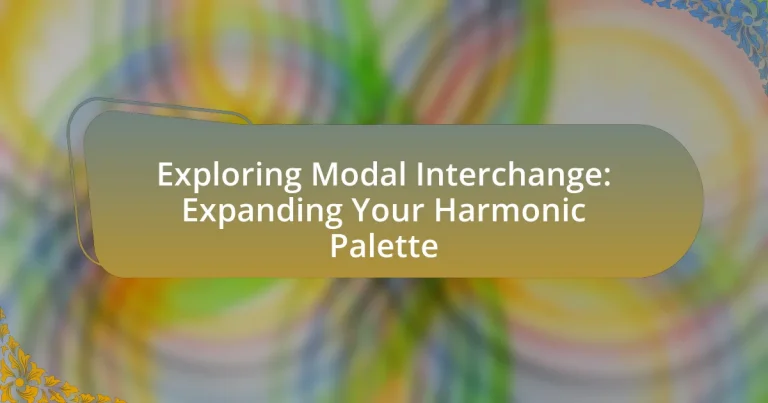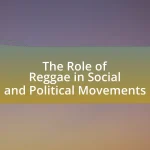Modal interchange is a musical technique that involves borrowing chords from parallel modes to enhance harmonic progressions, allowing for greater emotional depth and complexity in compositions. This article explores the fundamental concepts of modal interchange, its significance in expanding harmonic creativity, and its application across various genres, including jazz and pop. Key topics include the differences between modal interchange and traditional harmony, the role of borrowed chords, and practical techniques for integrating modal interchange into compositions and improvisations. Additionally, the article addresses common challenges musicians face when using this technique and offers best practices for effective implementation.

What is Modal Interchange?
Modal interchange is the practice of borrowing chords from a parallel mode to enrich harmonic progressions. This technique allows composers and musicians to create more varied and expressive music by incorporating elements from different scales, such as using chords from the parallel minor when in a major key. For example, in the key of C major, a composer might use the A♭ major chord, which is derived from C minor, to add emotional depth and contrast. This method is widely utilized in various genres, including jazz and pop, to enhance musical texture and complexity.
How does Modal Interchange enhance harmonic creativity?
Modal interchange enhances harmonic creativity by allowing composers and musicians to borrow chords from parallel modes, thereby expanding their harmonic vocabulary. This technique enables the introduction of unexpected tonal colors and emotional nuances, which can lead to more innovative and diverse musical expressions. For instance, a piece in C major can incorporate chords from C minor, such as the iv chord (F minor), creating a richer harmonic landscape. The use of modal interchange has been a hallmark in various genres, including jazz and rock, where artists like The Beatles and Miles Davis have effectively utilized this approach to push the boundaries of traditional harmony.
What are the fundamental concepts of Modal Interchange?
The fundamental concepts of Modal Interchange involve the use of modes from parallel scales to enrich harmonic progressions. Modal Interchange allows composers to borrow chords from related modes, such as using the iv chord from the parallel minor in a major key context. This technique enhances emotional expression and creates varied tonal colors within a piece. For instance, in C major, incorporating chords from C minor, like Bb major or Ab major, exemplifies Modal Interchange. This practice is rooted in the principles of functional harmony and modal theory, which highlight the relationship between different scales and their respective chords.
How does Modal Interchange differ from traditional harmony?
Modal interchange differs from traditional harmony primarily in its use of modes rather than a single tonal center. Traditional harmony typically relies on major and minor scales, establishing a clear tonal hierarchy, while modal interchange allows for the borrowing of chords from parallel modes, such as using chords from the Dorian or Mixolydian modes in a piece primarily in a major key. This practice enriches harmonic vocabulary and creates varied emotional textures, as evidenced by its frequent use in jazz and contemporary music, where artists often shift between modes to enhance expressiveness and complexity.
Why is Modal Interchange important for musicians?
Modal interchange is important for musicians because it allows them to borrow chords from parallel modes, thereby expanding their harmonic palette and enhancing musical creativity. By incorporating chords from different modes, musicians can create richer, more varied emotional landscapes in their compositions. For example, a piece in C major can utilize chords from C minor, such as the iv chord (F minor), to introduce unexpected tension and resolution. This technique has been widely used in various genres, including jazz and pop, demonstrating its effectiveness in creating unique soundscapes and engaging listeners.
What benefits does Modal Interchange provide in composition?
Modal interchange enhances composition by allowing composers to borrow chords from parallel modes, thereby enriching harmonic variety and emotional depth. This technique enables the introduction of unexpected tonal colors, which can create tension and resolution, ultimately leading to more engaging musical narratives. For instance, a piece in C major can incorporate chords from C minor, such as the iv chord (F minor), to evoke a contrasting mood. This practice not only broadens the harmonic palette but also facilitates smoother transitions between different emotional states within a composition.
How can Modal Interchange improve improvisation skills?
Modal interchange can improve improvisation skills by allowing musicians to access a broader range of harmonic possibilities, enhancing creativity and expression. By incorporating chords from parallel modes, musicians can create unexpected and interesting progressions, which can lead to more dynamic and engaging improvisations. For example, a musician improvising in C major can borrow chords from C minor, such as the iv chord (F minor), to introduce tension and contrast. This technique not only enriches the harmonic texture but also encourages musicians to think outside traditional tonal boundaries, ultimately fostering greater improvisational flexibility and originality.

What are the different modes used in Modal Interchange?
The different modes used in Modal Interchange include Dorian, Phrygian, Lydian, Mixolydian, Aeolian, and Locrian. These modes are derived from the major scale and allow composers and musicians to borrow chords and melodies from parallel modes, enriching harmonic possibilities. For example, in the key of C major, one can interchange chords from C Dorian (D minor) or C Lydian (F major), creating varied emotional textures and colors in music. This practice is widely utilized in genres such as jazz and rock, where modal interchange enhances the harmonic palette.
How do various modes contribute to harmonic diversity?
Various modes contribute to harmonic diversity by providing distinct tonal frameworks that alter the emotional and sonic characteristics of music. Each mode, such as Dorian, Phrygian, or Mixolydian, introduces unique intervals and scale degrees that create different harmonic relationships. For instance, the Dorian mode features a minor third and a major sixth, which can evoke a more uplifting feel compared to the natural minor scale. This diversity allows composers and musicians to explore a wider range of emotional expressions and textures in their compositions, enhancing the overall richness of the music.
What are the characteristics of the major and minor modes?
Major modes are characterized by a bright, happy sound, typically built on a major scale with a specific pattern of whole and half steps (W-W-H-W-W-W-H). In contrast, minor modes convey a darker, sadder tone, constructed from a minor scale that follows a different pattern (W-H-W-W-H-W-W). The major mode’s third interval is a major third, while the minor mode features a minor third, which contributes to their distinct emotional qualities. These characteristics are foundational in Western music theory, influencing composition and improvisation across various genres.
How do modal scales like Dorian and Mixolydian function in interchange?
Modal scales like Dorian and Mixolydian function in interchange by providing alternative tonalities that can enrich harmonic progressions. Dorian, characterized by a minor third and a major sixth, allows for the incorporation of major chords in a minor context, creating a unique blend of tension and resolution. Mixolydian, with its major third and flat seventh, facilitates the use of dominant chords in a major context, offering a bluesy or jazzy feel. This interchange enhances musical expression by allowing composers and performers to shift between modes, thus expanding the harmonic palette and creating varied emotional landscapes. The effectiveness of these modal scales in interchange is evidenced by their frequent use in genres such as jazz, rock, and funk, where musicians often exploit modal shifts to create dynamic and engaging compositions.
What role do borrowed chords play in Modal Interchange?
Borrowed chords serve as a crucial element in modal interchange by introducing harmonies from parallel modes, thereby enriching the tonal palette of a piece. This technique allows composers and musicians to create contrast and emotional depth by utilizing chords that are not typically found in the original key. For instance, in a piece written in C major, borrowing the bVII chord from C Mixolydian can add a unique flavor and tension that enhances the overall harmonic structure. The effectiveness of borrowed chords in modal interchange is evidenced by their frequent use in various musical genres, including jazz and rock, where they contribute to innovative chord progressions and expressive melodies.
How can borrowed chords be effectively integrated into compositions?
Borrowed chords can be effectively integrated into compositions by utilizing them to create contrast and emotional depth. Composers can introduce borrowed chords from parallel modes to enhance harmonic variety, such as using a bVII chord from the Mixolydian mode in a major key context, which adds tension and interest. This technique is supported by the practice of modal interchange, where chords from different modes are employed to enrich the harmonic language of a piece. For example, in a C major composition, incorporating an F minor chord (borrowed from C minor) can evoke a different emotional response, demonstrating the effectiveness of this approach in expanding the harmonic palette.
What are some common examples of borrowed chords in popular music?
Common examples of borrowed chords in popular music include the use of the bVII chord, which is often found in rock and pop songs. For instance, in “Sweet Home Alabama” by Lynyrd Skynyrd, the bVII chord (D major) is borrowed from the Mixolydian mode. Another example is the use of the iv chord in a major key, as seen in “Someone Like You” by Adele, where the iv chord (F minor) is borrowed from the parallel minor key. Additionally, the bIII chord appears in “Creep” by Radiohead, showcasing modal interchange by borrowing from the parallel minor scale. These examples illustrate how borrowed chords enhance harmonic richness and emotional depth in popular music.

How can musicians apply Modal Interchange in their work?
Musicians can apply Modal Interchange by borrowing chords from parallel modes to create harmonic variety and emotional depth in their compositions. For example, a musician working in C major can incorporate chords from C minor, such as B♭ major or E♭ major, to introduce contrasting colors and moods. This technique enhances the overall texture of the music, allowing for unexpected shifts that can captivate listeners. Historical examples include the use of Modal Interchange in jazz and rock music, where artists like Miles Davis and The Beatles effectively utilized this approach to enrich their harmonic language.
What techniques can be used to incorporate Modal Interchange?
Modal interchange can be incorporated using techniques such as borrowing chords from parallel modes, utilizing modal scales, and applying modal harmony in chord progressions. Borrowing chords from parallel modes allows composers to introduce unexpected harmonic colors, enhancing emotional expression. For example, in a C major context, using chords from C minor, such as Bb or Ab, creates a richer harmonic texture. Utilizing modal scales, like Dorian or Mixolydian, provides alternative melodic frameworks that can be layered over traditional progressions, further expanding the harmonic palette. Additionally, applying modal harmony in chord progressions, such as alternating between major and minor chords derived from different modes, can create dynamic shifts in mood and tension. These techniques are widely recognized in music theory and practice, demonstrating their effectiveness in enriching musical compositions.
How can chord progressions be altered using Modal Interchange?
Chord progressions can be altered using Modal Interchange by borrowing chords from parallel modes to create new harmonic textures. For example, in a piece written in C major, one might incorporate chords from C minor, such as the iv (F minor) or bVII (B♭ major), to introduce unexpected emotional shifts and color. This technique enhances the harmonic palette by allowing composers to explore different moods and tensions, as evidenced by its use in various genres, including jazz and rock, where modal interchange is frequently employed to enrich the musical narrative.
What are some practical exercises for practicing Modal Interchange?
Practical exercises for practicing modal interchange include transposing common chord progressions into different modes, such as using a major scale and incorporating chords from its parallel minor. Another effective exercise is to create melodies that switch between modes, allowing for the exploration of different tonal colors. Additionally, improvising over a static chord while alternating between modes can enhance understanding of modal characteristics. These exercises reinforce the concept of modal interchange by providing hands-on experience with the harmonic and melodic shifts that define it.
What are the common challenges faced when using Modal Interchange?
Common challenges faced when using Modal Interchange include the difficulty in maintaining tonal coherence and the potential for dissonance. Musicians often struggle to seamlessly integrate modes from different keys, which can lead to confusion in the harmonic structure. Additionally, the lack of established guidelines for modal transitions can result in compositions that feel disjointed or lack a clear direction. These challenges are particularly evident in genres that rely heavily on modal interchange, such as jazz and progressive rock, where the complexity of the harmonic language can overwhelm both performers and listeners.
How can musicians overcome the difficulties of Modal Interchange?
Musicians can overcome the difficulties of modal interchange by developing a strong understanding of both the modes involved and their respective tonalities. This foundational knowledge allows musicians to effectively navigate between different modes, ensuring smooth transitions and coherent musical phrases. For instance, practicing modal scales and their corresponding chords helps musicians internalize the sound and feel of each mode, making it easier to incorporate them into compositions. Additionally, analyzing existing works that utilize modal interchange can provide practical examples and inspire creative applications. By combining theoretical knowledge with practical exercises, musicians can enhance their ability to use modal interchange effectively in their music.
What mistakes should be avoided when experimenting with Modal Interchange?
When experimenting with Modal Interchange, musicians should avoid the mistake of neglecting the foundational key center, as this can lead to dissonance that feels unintentional. Maintaining a clear tonal center ensures that the modal shifts enhance rather than confuse the harmonic structure. Additionally, failing to consider the emotional context of the modes can result in a lack of coherence in the musical narrative. For instance, using a minor mode interchangeably without acknowledging its darker emotional implications may mislead the listener. Lastly, overusing modal interchange without proper integration can make the music feel fragmented; thus, it is crucial to blend modal elements seamlessly into the existing harmonic framework.
What are some best practices for utilizing Modal Interchange effectively?
To utilize Modal Interchange effectively, musicians should incorporate chords from parallel modes to enhance harmonic richness. This practice allows for the introduction of unexpected colors and emotional depth in compositions. For instance, using the bVII chord from the Mixolydian mode in a major key can create a compelling contrast, as seen in many rock and jazz pieces. Additionally, applying Modal Interchange in transitions can smoothen shifts between sections, providing a seamless flow while maintaining listener interest. This technique is supported by numerous examples in contemporary music, where artists frequently borrow chords from related modes to create unique soundscapes.


